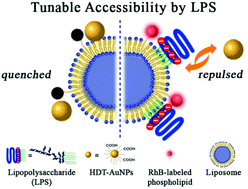Tunable accessibility of dye-doped liposomes towards gold nanoparticles for fluorescence sensing of lipopolysaccharide†
Abstract
Inspired by the primitive role of lipopolysaccharide (LPS) and taking advantage of the membrane-philic properties of amphiphilic gold nanoparticles (AuNPs), we established a facile and efficient fluorescence turn-on detection strategy for LPS. Upon binding onto the surface of liposomes, LPS can tailor the accessibility of liposomes towards AuNPs, reminiscent of its primitive function on the surface of bacteria. Thus, while the fluorescence of the dyes labeled on liposomes can be markedly quenched by the membrane-philic AuNPs, the quenching effect can be efficiently prevented by the surface-bound LPS. The de-quenching effect is highly selective to LPS, relative to other negatively charged bio-analytes, which is due to not only the extremely high affinity of LPS to lipid bilayers, but also the unique molecular structure of LPS. Furthermore, this easy-to-construct method offers a limit of detection of ∼0.65 nM, which is comparable to that obtained from the superb synthetic sensors for LPS reported in the literature. This study would open up a new route for the design of sensing systems for LPS exploiting its unique structural pattern and primitive function.



 Please wait while we load your content...
Please wait while we load your content...